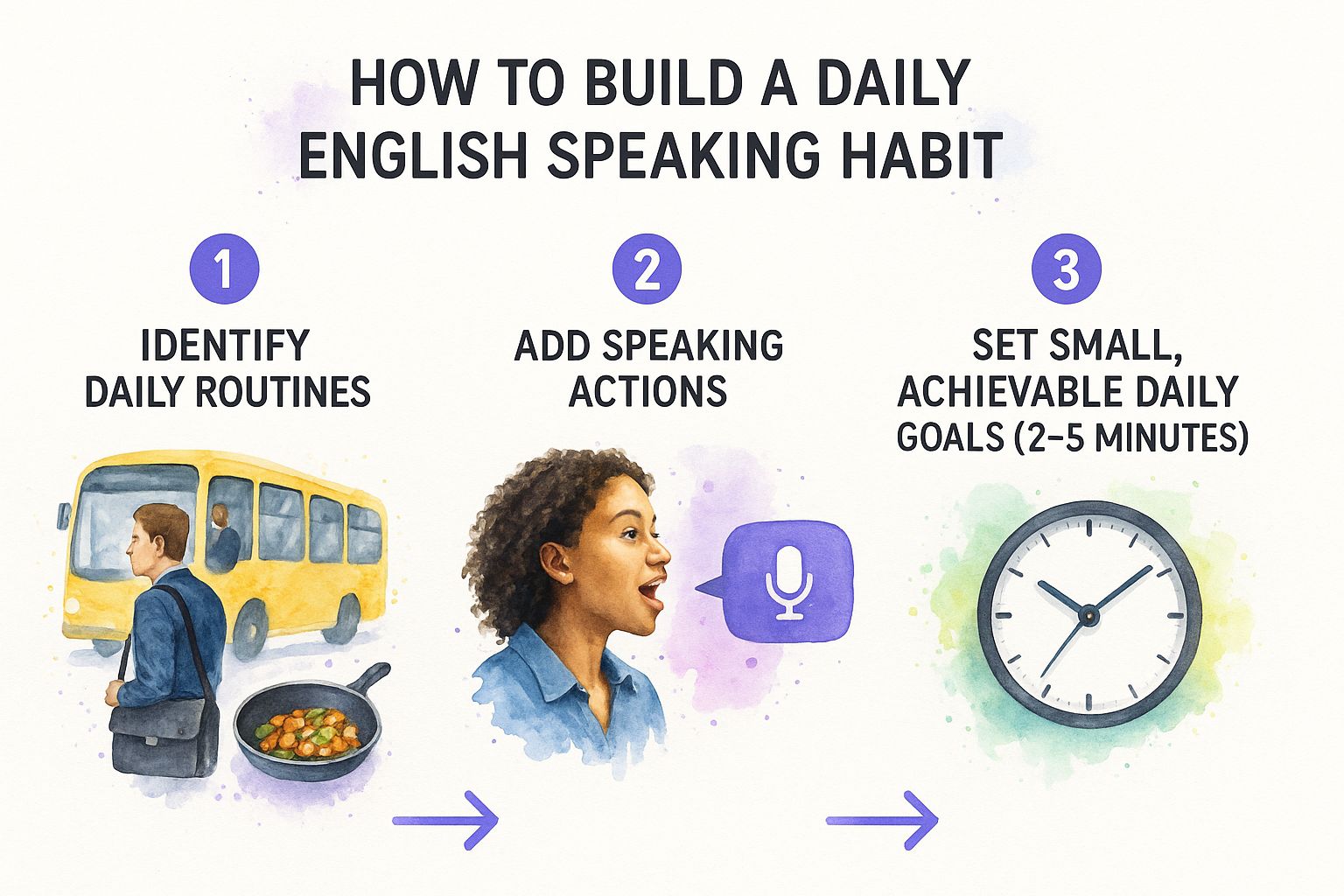How to Practice English Speaking and Gain Fluency
Discover how to practice English speaking with proven techniques and daily habits. This guide offers actionable advice to improve your fluency and confidence.


Here’s the thing about learning how to practice English speaking: it’s not about finding massive, two-hour blocks of time for intense study. Forget that. The real secret is building a small, consistent habit that you can actually stick with every single day.
It’s about weaving tiny moments of practice into the life you’re already living. Focus on consistency, not perfection.
Build a Daily Speaking Habit You Can Actually Keep
So many learners I've worked with burn out because they think they need to schedule these long, formal study sessions. That almost never works. A much better way is to create your own personal "language bubble" right at home, turning those everyday, mundane moments into powerful practice opportunities.
This way, you're not trying to find extra time—you're just repurposing the time you already have.
Think about it. Your morning commute? That’s a perfect time to describe the scenery out loud in English. Cooking dinner? Narrate the steps you're taking as if you're hosting a cooking show. These little actions add up, building momentum without ever feeling like a chore.
Start with Micro-Goals
The trick is to set goals that are so small, they feel almost too easy to skip. Seriously. Aim for just two to five minutes of speaking at a time. It could be as simple as sending one voice note to a friend in English or just thinking out loud about your plans for the day.
This infographic breaks down a simple three-step process for getting this started.

As you can see, the whole idea is to piggyback a new speaking habit onto a routine you already do without thinking.
This approach does more than just build a habit; it prepares you for how English is actually used in the real world. A fascinating statistic I always share with students is that only about 4% of global English conversations happen between two native speakers. That means most of the time, you'll be speaking with other learners, where clear communication is way more important than perfect grammar. You can read more about global English usage trends and what they mean for you.
The real goal isn't to sound like you're from London or New York. It's to communicate your ideas clearly and confidently with people from anywhere in the world. Your daily habits should be built around that.
Your First Week Speaking Practice Plan
To get you started, I've put together a simple 7-day plan. The goal here isn't to be perfect—it's just to show up and speak for about 15 minutes each day. Try it out and see how it feels.
| Day | Activity (15-20 Minutes) | Goal |
|---|---|---|
| Day 1 | Describe your room out loud for 5 minutes. Then, do a 10-minute roleplay in TalkEasy ordering coffee. | Use basic descriptive words and practice a simple transaction. |
| Day 2 | Think aloud while making breakfast. Talk about what you're doing and your plans for the day. | Get comfortable narrating your actions in real-time. |
| Day 3 | Find a news article and read the first paragraph out loud. Then, summarize it in your own words. | Practice pronunciation and summarizing information. |
| Day 4 | Use TalkEasy's "Debate" scenario. Pick a simple topic like "Cats vs. Dogs" and argue one side. | Form and express a simple opinion. |
| Day 5 | Record a 2-minute voice note on your phone talking about your favorite movie. Listen back to it. | Practice speaking for a set duration and self-correction. |
| Day 6 | Call a friend or family member and have a 5-minute conversation with them in English. | Apply your practice in a real, low-stakes conversation. |
| Day 7 | Review your week. Talk out loud about which activity was easiest, hardest, and what you learned. | Reflect on your progress and build self-awareness. |
This is just a template, of course. Feel free to swap out activities with whatever feels most interesting to you. The key is to just get the reps in and make speaking a normal part of your day.
Listen and Mimic Like a Native Speaker

If you want to sound more natural when you speak English, you have to start by being a really active listener. I'm not just talking about understanding the vocabulary. It’s about tuning your ear to the music of the language—the rhythm, the pitch, and the stress that native speakers naturally put on certain words.
Think about it: the best speakers are almost always fantastic listeners. They instinctively pick up on how native speakers link words together, when their voice goes up or down, and which words they emphasize. This is the secret sauce that makes speech flow instead of sounding stiff and robotic.
Try the Shadowing Technique
One of the most effective ways I've seen students improve their flow is through a method called shadowing. It sounds a bit strange, but it works wonders. You simply listen to a short piece of audio from a native speaker and repeat exactly what they say, just a fraction of a second behind them.
The key is not to wait for them to finish the sentence. You are literally their "shadow," copying their speech as it happens. Doing this forces your mouth to form the right shapes and helps you internalize the natural cadence of English.
Don't aim for perfect pronunciation right away. Shadowing is about building muscle memory for the melody and rhythm of English. Honestly, a strange rhythm can be a bigger giveaway of a non-native speaker than one or two mispronounced words.
Here’s a quick way to try it: grab a 30-second clip from a podcast or even a scene from your favorite TV show. Listen to it once to get the general idea. Then, hit play again and start shadowing. It’ll feel clumsy at first, but stick with it. This is a powerful exercise for polishing your delivery and a big part of how you can learn an English accent that feels authentic.
This kind of constant exposure is a big reason why people in countries like the Netherlands are often so good at English. They grow up watching movies in English with subtitles, not dubbed versions, so they’re always hearing the real thing. It’s a fascinating look into how immersion shapes language skills.
Get Unlimited Speaking Time with AI
One of the toughest parts of learning to speak English is simply finding someone to practice with. Trying to sync up schedules across different time zones is a nightmare, and let's be honest, the fear of sounding silly in front of a real person is a major hurdle for a lot of us.
This is where AI has completely changed the game. It offers a judgment-free space to talk, mess up, and try again, anytime you want.
AI-powered tutors like TalkEasy give you a chance to have endless conversations without any of the usual pressure. You can chat about anything, try out new words you just learned, and get into the rhythm of a natural conversation—all in private. It’s an incredible confidence booster.
Practice for Real Life, Not Just for Practice
The real magic of using an AI tutor is the ability to role-play situations you’ll actually encounter. Instead of just making small talk, you can prepare for specific, practical moments. This is what turns practice into a practical skill.
For example, you could run through scenarios like:
- A job interview: Get comfortable answering those tricky "tell me about yourself" questions and explaining your experience.
- Ordering food: Practice everything from asking for a table to navigating a menu and paying the check.
- Making a phone call: Run a drill for booking a doctor's appointment or dealing with a customer service issue.
The screenshot below from TalkEasy shows just how easy it is to pick a scenario and dive right in.

When you practice these specific interactions over and over, you’re building muscle memory. The right words and phrases will come to you automatically, so you won’t feel that panic and freeze up when it's the real deal.
But it’s not just about the conversation. These tools also provide instant, gentle feedback on your pronunciation and grammar. This helps you spot and fix little mistakes before they turn into bad habits. It’s like having a personal coach on call 24/7.
If you're serious about improving, it's worth exploring all the different ways you can get English conversation practice online to find what works best for you.
The point of practicing with AI isn’t to avoid talking to people. It's to get you ready for it. When you build a solid foundation in a low-stakes environment, you'll feel so much more prepared and confident when you step into real-world conversations.
Build Vocabulary You'll Actually Use in Conversation
https://www.youtube.com/embed/ZM6Sg4SN7kU
Have you ever spent hours memorizing long lists of words, only to find you can't recall any of them when you actually need to speak? It's a classic language-learning trap. The goal isn't just to know a lot of words; it's to build a practical vocabulary that feels natural in real conversations.
Instead of learning words in isolation, try grouping them by topic. Think about a situation you'll likely face soon. If you have a business meeting on the calendar, you could focus on learning words like agenda, action items, stakeholders, and follow-up.
When words are linked by context, your brain creates stronger connections, making them much easier to pull up when you're on the spot.
Think in Phrases, Not Just Words
One of the best ways to sound more natural is to learn collocations—words that just sound right together to a native speaker. We say “make a decision,” not “do a decision.” We talk about “heavy rain,” not “strong rain.”
Learning these natural word partnerships is a shortcut to sounding more fluent. It's a small change in how you study, but it makes a huge difference in how other people understand you.
The moment you start learning collocations, you stop translating word-for-word from your native language. You begin thinking in English phrases, which is a massive leap toward genuine fluency.
From now on, when you learn a new word, don’t just write it down by itself. Jot down the words that usually go with it.
- Instead of just "promise," learn "make a promise" or "keep a promise."
- Instead of just "attention," learn "pay attention."
- Instead of just "time," learn "save time" or "waste time."
Building your vocabulary this way is far more effective for speaking practice. When you're ready to use these new phrases, you can find some great ideas in our guide on conversation topics for adults to give your practice a clear direction.
Find Real-World Speaking Opportunities

Alright, you've put in the work practicing on your own and with AI. Now it’s time for the main event: talking with real people. This is where the magic happens, but it’s also where nerves can kick in. The secret is to find friendly, low-pressure situations to start applying everything you’ve learned.
Finding someone to talk to is easier than you might think. There are countless language exchange apps and websites designed to connect you with native speakers and fellow learners across the globe. Many let you ease in with text chats before you ever have to jump on a voice call, which is a great way to build confidence.
Get the Most from Your Conversations
Just showing up for a chat isn't quite enough—you need a game plan to make these conversations truly valuable. Before you dial in, jot down a few simple topics or questions. This little bit of prep work is a lifesaver for avoiding those dreaded awkward silences and helps you steer the conversation toward vocabulary you actually want to practice.
And please, don't be shy about asking for the specific feedback you need. Your conversation partner isn't a mind reader!
You could say things like:
- "Could you correct me if I make a big mistake with a verb tense?"
- "I'm really working on my pronunciation of the 'th' sound. Can you let me know how I'm doing?"
- "Does this phrase sound natural to you, or is there a better way to say it?"
Most people are more than happy to help when they know exactly what you’re focused on. This simple step transforms a casual chat into a powerful, targeted practice session.
Your goal in these conversations isn't perfection; it's communication. Every single interaction, no matter how short, is a win. It builds the mental muscle you need to handle real-world English conversations without freezing up.
This is how you finally bridge the gap between knowing English and actually using it. You’ll get comfortable with different accents, conversational speeds, and the beautifully unpredictable flow of a real discussion.
Got Questions About Speaking English? We’ve Got Answers.
As you start practicing your spoken English, it's completely normal for questions and doubts to pop up. It’s easy to get hung up on these worries, but getting some perspective can help you push past them and keep moving forward. Let's tackle some of the most common concerns I hear from learners all the time.
How Long Until I’m Fluent?
This is the big one, isn't it? But here’s the thing: fluency isn’t some finish line you cross. It’s more of a moving target, and everyone's path looks different. Your background, how often you practice, and what you’re aiming for all play a huge role.
Instead of getting fixated on "fluency," shift your focus to small, consistent daily efforts. Most learners I've seen who commit to just 15 to 30 minutes of real speaking practice every day notice a massive jump in their confidence and conversational skills within three to six months. The trick is to celebrate the small victories along the way, like getting through a five-minute chat without second-guessing every word.
Should I Stress About Perfect Grammar or Just Talk?
When you're starting out, just talk. Seriously. The main goal is to get your point across. If you’re constantly pausing to fix every little grammatical slip-up, you’ll kill the natural rhythm of the conversation and, more importantly, your own confidence.
Concentrate on expressing your thoughts first and foremost. You can always circle back later to polish your grammar with specific exercises or feedback from an AI tutor or a language partner. And remember, even native speakers bend the rules and make mistakes.
Mistakes aren't failures; they're proof you're actually trying. Every error is a chance to learn, not something to fear. The more you speak, the more you’ll see that messing up is a totally normal—and necessary—part of the journey.
I'm Shy—How Can I Possibly Practice?
Shyness is a huge hurdle for so many learners, so the key is to start somewhere you feel completely safe. Practicing by yourself is a fantastic first step. Try simply narrating what you’re doing throughout the day or describing the objects in your room. It sounds simple, but it works.
Another great way to ease in is with an AI tutor like TalkEasy. It’s a completely judgment-free zone where you can just talk. Once you’ve built up a bit of confidence on your own terms, you can graduate to one-on-one online language exchanges. They tend to feel way less intimidating than jumping into a group conversation.
Ready to put these ideas into practice? TalkEasy gives you that safe, judgment-free space to speak whenever you want. Build your confidence with AI-driven conversations and get instant feedback to speed up your progress. Why not start your first conversation today?